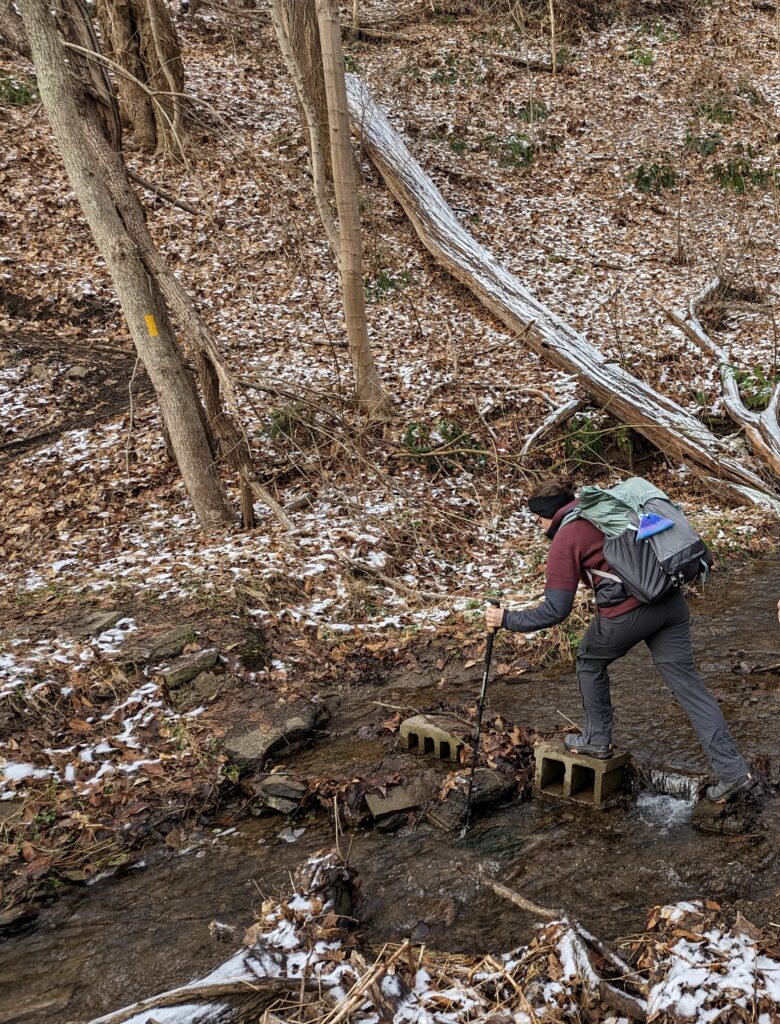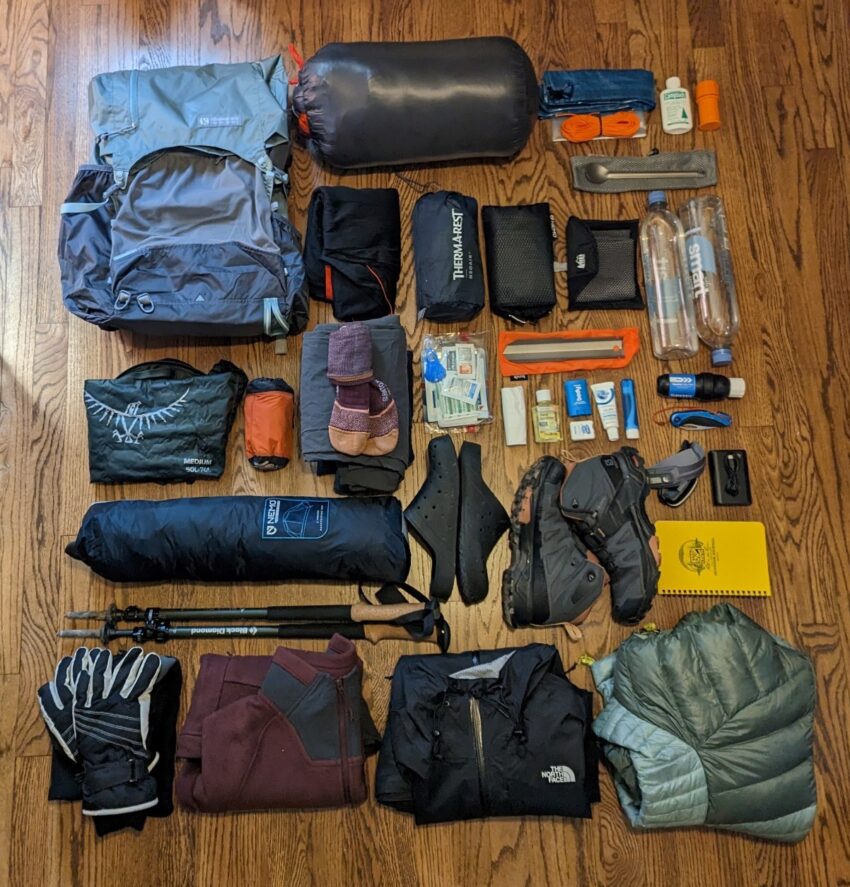Thru-Hikers have a trail reputation of being gear-obsessed. Some hikers could drone on for hours and hours about the agonizing decision process and why the tent, shoes, or toilet paper they have with them is the absolute BEST ANSWER like it was a life-and-death multiple-choice exam. This post is nothing like that, mostly because the decision process for how I chose certain products over others is relatively boring: I primarily considered product weight, cost, and Thru-Hiking ratings when acquiring new gear, but I also looked compared things like an “R Rating” for thermal insulation for my sleeping kit to help me stay warm (or alive) in the Smokies at night. I didn’t stress out too much over getting the “perfect” equipment, and tried to enjoy the process as much as possible.
How much a product weighs is a pretty big deal. Some folks may cut an extra 6 inches of flapping canvas strap off of their pack to ditch the hundredths of an ounce, because weight matters. That 0.05-ounce doesn’t seem like much when you’re bouncing around in your living room testing the fit of your pack, but once you carry it for a few hundred miles you might start hating the sight of anything that isn’t truly necessary. Gear “shakedowns” are common in the first few weeks of the trail, when hikers have had some time to really use their gear and determine what is working and what isn’t; some items might be sent home, and others may be added. I’ll be packing light with minimal luxury items from the beginning in a fervent effort to save room for more of my favorite thing: food.
Without further ado, here’s the list of the Things I Plan To Carry starting on Day 1:
- Pack: Gossamer Gear Mariposa 60L
- Waterproof Pack Liner: Osprey Pack Liner (M)
- Waterproof Pack Cover: Sea to Summit pack cover from my previous fieldwork days
- Tent: NEMO Hornet Elite 2-Person Tent + Footprint to prevent damage to the bottom of the tent
- Sleeping Bag: REI Magma 15 (Rated for 17 degrees F)
- Sleeping Bag Liner: Sea to Summit Thermolite Reactor Liner (Adds 14 degrees F of warmth)
- Sleeping Pad: ThermaRest NEO X-Lite Air
- Trekking Poles: Black Diamond Cork-Handled poles
- Hiking Shoes: Salomon X-Ultra 4 Gore-Tex boots. I was originally planning on hiking in trail running shoes, but they didn’t hold up to a few inches of snow during a training hike. I switched to these lightweight and flexible (but still waterproof) hiking boots, and haven’t had any issues during several practice hikes. As I mentioned in my FAQ post, I’ll go through three to five total pairs of shoes, so this is just the first of many!
- Clothing: Wool base layers, hiking cargo pants and t-shirt, fleece, down insulating jacket, hat (or in my case a full balaclava) and gloves, camp shoes (knock-offs of those rubber clogs we all love to hate…don’t knock ’em till you try ’em!), camp shorts and t-shirt, and the “underlying” essentials.
- Socks: Important enough to be in their own category. Wool socks are an absolute must, and I’ll be taking some cushioned socks from Farm-to-Feet and Darn tough. Most folks only take 2 pairs at a time, wearing one consistently until they are almost unrecognizable, and saving the other pair for camp to give your feet a break.
- Mess Kit Supplies: HDPE Bear Bag and Hanging Line, Camp Suds (biodegradeable, trail-safe soap to use on dishes and people), waterproof matches (thanks, Russell!), long-handled spork and spoon to use with my deep food bags, Smartwater bottles which are lighter than nalgenes and cheaper to replace, and a Sawyer Squeeze water filter.
- First Aid Kit: While the goal is to never need this, of course it’s better to be prepared. I have small amounts of over-the-counter painkillers, bandages, a few alcohol wipes, antibiotic ointment packets, tweezers, nail clippers, and a tick removal tool.
- Other incidentals: hygiene supplies like toothbrush/toothpaste, toilet paper and hand sanitizer, a headlamp, a camp towel to dry off my tent before shoving into my pack, a lightweight knife (thanks, Russell!) which I plan to use primarily to open food bags, a power brick to charge my phone between towns, my titanium cat-hole digging tool which could also double as a horrifying self-defense implement due to its serrated edges, and a waterproof journal.
There are a few other odds and ends that will likely make it into my pack before I leave, but these are the big things! My base weight (everything besides food and water) will be somewhere around 15 to 16 pounds, so my total pack weight should be somewhere between 20 and 25 pounds. Not bad! Here’s a photo of me bumbling over one of many stream crossings on the Rachel Carson Trail during a long practice hike. My pack didn’t have quite all of my gear in it so it was a little more compact than it will be on the AT, but I did sneak an 8-lb dumbbell into it to make up for the missing weight!

While the gear and equipment in a Thru-Hiker’s pack can make or break the Appalachian Trail dream for some, the most important thing a hiker takes with them is their mind. Your equipment won’t tell you to keep going when things aren’t going your way, so it’s up to you and your grit to make that decision and keep making it for 2,200 miles. Dr. Warren Doyle, creator and director of the Appalachian Trail Institute and 18-time AT Thru-Hiker, offers the following mental preparedness tips in a book introduction for Jennifer Pharr Davis’ AT biography Becoming Odyssa:
- “Walking the entire Appalachian Trail is not recreation. It is an education and a job.”
- “Don’t fight the Trail. You have to flow with it. Be cooperative with the Trail, neither competitive nor combative.”
- “Time, distance, terrain, weather, and the Trail itself cannot be changed. You have to change. Don’t waste any of your energy complaining about things you have no control over. Instead, look at yourself and adapt your mind, heart, body, and soul to the Trail. Remember, you will be a guest in somebody else’s house the entire journey.”
- “Fear is weight.”
- “It is far better, and less painful, to learn to be a smart hiker rather than a strong hiker.”
- “Leave your cultural ‘level of comfort’ at home. Reduce your material wants while concentrating on your physical and spiritual needs.”
- “We all have our own temperaments, levels of comfort, and thresholds of pain. If these are congruent with what the Trail requires, you should succeed on your pilgrimage.”
One of the biggest pieces of advice from previous Thru-Hikers is “Never decide to quit on a rainy day or on an uphill.” The Trail will test mettle and push limits, and part of becoming a Thru-Hiker is rolling with the punches, commitment, and balancing preparedness and flexibility (AKA hiking smarter not harder). A lot of folks also say that there’s no way to fully prepare for a Thru-Hike…so there will always be some surprises to navigate. I’m not sure what the hardest part about hiking the AT will be, but one thing I can say with certainty is that it will definitely be an adventure!! I’m excited for the challenges that lie ahead, and am looking forward to working through them…Fear is weight.
Thanks for stopping by!

Love this! Love you! Rooting for you in every way. Hope to see you out there!! ❤️
Great post .. Love the detailed information. I found the tips by Dr. Warren Doyle particularly insightful. Seems like good advice for this journey we call “life” as well as for being an AT Thru hiker !
Enjoyed reading this!
I loved the list of advice you shared from Becoming Odyssa! Sounds like the trail will be a great training ground for mindfulness and character growth. You might come back transformed into a monk 😉 Love you, friend!
We’re so excited for your hike. You have really honed the gear down to necessities and your discipline will pay off! I’m sure you’re right- food will be the big priority!
Cindy and Craig
Love your blog. It will be quite an adventure. Keeping you and friend in our prayers.
I love Salomon shoes!, they should hold up well!
Thinking of you!, know you start tomorrow! 😘
Definitely would have gone with the boots , heavier but also heavier duty,, also would have an antihistamine and epi pen, not fear weight just to buy you time to get yourself or co hiker to a phone or road. So well written you should publish your AT story!